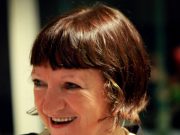Last Sunday I went to see the Shang-Chi Sung dance company perform at Dock 11.
Shang-Chi Sung is a Taiwanese dancer and choreographer.
From an early age, just like his mother, he was heavily influenced by his love of dance. So much so that at 14 years old, he wanted to move to the capital city in order to cultivate what had become his true passion. His mother enrolled him into the National Dance Academy of Arts in Taipei, where Shang-Chi went on to study Modern dance, Ballet and Chinese Folk dance.
After this period, he moved to Berlin, where he graduated from the University of Ernst Busch with a Master of Arts in choreography.
With his dance company, which was founded in 2007, he has choreographed many different pieces, which have been presented all over Europe and Asia. Amongst these are “Traverse” and “Uphill” which were performed the other evening at Dock 11.
At the entrance, as I collected my tickets, I was immediately touched by the fact that we were given a pair of ear plugs. As soon as the performance began, it became apparent that the music would play a central role in the choreography – it was an electronic composition that was both fast and hypnotic – but I couldn’t understand why we had been handed these acoustic insulators; it didn’t really seem necessary. In any case, even though the volume of the music didn’t necessitate the use of the plugs, I tried them out, only to discover an unexpected effect.
With the ear plugs in my my ears, it felt as though the music were coming from the inside of my body, and that the movements of the dance physically and externally represented the sound that I could hear.
The first piece of choreography to be performed on stage (“Traverse”) was a very brief but intense solo. The movements of Shung-Chi Sung, the dance/choreographer, which were at first slow and calibrated, and then fast and rhythmic, were incredibly precise, even when they were transformed into a dizzying sequence. I was surprised, because the exact point from which every gesture departed, was always visible, as well as the fluidity of its execution.
The next piece, “Uphill”, seemed like a natural continuation of the first arrangement.
If during the first dance, the dancer became aware of space through his movements, in “Uphill” – which consisted of a trio – the dancers discovered one another.
The format that allowed the dancers to meet, was repeated through a corporal and codified language, which allowed the spectator to follow the evolution of the choreography in a linear and reassuring manner. The “un-casual” contact between the dancers insinuated the idea of longing and the search for the other, also prevalent in real life.
It was the same choreographer that explained to me how friends and family had helped him to feed his passion for dance and choreography, and that he obtains the greatest sense of satisfaction from seeing his dancers fulfilled and happy at work and in their private lives.
Feeling buoyant from the beautiful dancing this evening, and excitedly looking forward to Nexus, the next piece by Shung-Chi Sung, I’ve promised myself to go and see the most recent success story from the dance company: “The Photographer” (choreographed to music by Philip Glass with 19 live musicians and three dancers/actors).














































